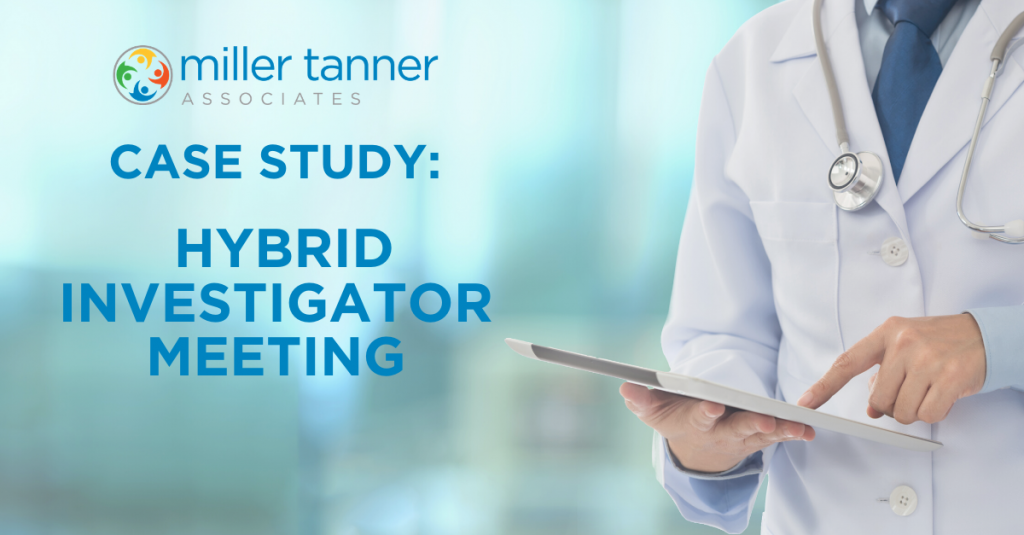
THE EVENT
U.S. Investigator Meeting for a Boston Biotech Company
THE CHALLENGE
Miller Tanner Associates (MTA) was asked to find a solution for an early June face-to-face (F2F) investigator meeting that could no longer take place due to the COVID-19 pandemic. While it was clear the June F2F event could not go forward as originally planned, the sponsor needed to meet their original FPI milestone and wanted to maintain a strong level of engagement with their sites.
THE SOLUTION
MTA designed a hybrid experience based on the goals and objectives of the sponsor, transforming a 3-day F2F investigator meeting into an interactive and engaging experience over multiple touchpoints. Instead of simply replacing the F2F investigator meeting with a virtual one, we developed a strategy to further maximize impact through a unique experience. MTA consulted with the sponsor to review the full agenda and separate their goals into those that could only be experienced F2F and those that could be experienced through a virtual solution.
Once the agenda was split into these two distinct categories, we further assessed which platform would best achieve the goals and objectives of the overall experience. To support our recommendation conducting shorter virtual meetings of 4 hours or less, MTA leveraged our Virtual Assessment Learning & Training Source (VALTs) product to provide non-critical training to the audience in advance of the virtual meeting in early June. Through VALTs, relevant training sessions will be built into learning modules within a library. Clinical site staff will then be provided a customized link to access role-based, study-specific training with read-acknowledge, and learning assessments. The sponsor will be able to monitor clinical site staff’s completion of core training in real-time, through this 21 CFR Part 11 supportive system. Training certificates will be generated for each individual member of the clinical site staff to clearly show their completion of the required training.
Utilizing VALTs to send pre-trainer content will enable the early-June virtual investigator meeting agenda to be much more focused. The sponsor will present critical content during this 4-hour event, which will also include live polling, break-out rooms, feedback modules, and other features designed to engage virtual audiences. This virtual / VALTs solution will allow the study to successfully launch and keep the sponsor’s goals on track. MTA will professionally record and edit the presentations (audio-synced to the presentation content) to also post within the VALTs library for the study. This allows clinical site staff to reference the material quickly and easily, as well as make available to new site staff to ensure consistent training and 100% compliance throughout the life of the study.
Recognizing the importance of site relationships and networking opportunities that a F2F investigator meeting provides, the sponsor strongly preferred to maintain a F2F component for their investigator meeting. As MTA assessed the full F2F agenda for the components most conducive for the Virtual / VALTs portion, we also recognized the opportunity to deliver an abbreviated F2F experience later in the year when it is safer to travel again post the COVID-19 crisis. The agenda for this 1.5-day meeting will center on relationship building and site engagement, even highlighting a panel of study coordinators from high-enrolling sites to talk through their best practices.
MTA successfully transform a 3-day U.S. investigator meeting into an experience that consists of VALTs (for both pre-trainer modules and hosting the virtual meeting presentations), a 4-hour virtual meeting to cover critical training for sites to get the study off the ground and running, and then an abbreviated 1.5-day F2F meeting later in the year to still allow for critical relationship and engagement opportunities. This hybrid solution is allowing for multiple touchpoints and engagement opportunities with the clinical site staff, keeping the study timeline on track, and providing needed flexibility for the attendees during this difficult time. The best part of this solution is that it all fits within the original budget of the longer F2F investigator meeting.
THE HIGHLIGHTS
- Leveraged MTA’s existing products, services, and 10+ years of virtual meeting expertise.
- Quickly able to transform the investigator meeting experience to keep the study timeline on track and still meet our customer’s goals and objectives.
- Created a virtual hybrid solution, ensuring consistent training and motivation of the clinical site staff, all while staying within the original budget.
Contact Miller Tanner if you are interested in a hybrid solution for your next investigator meeting.


